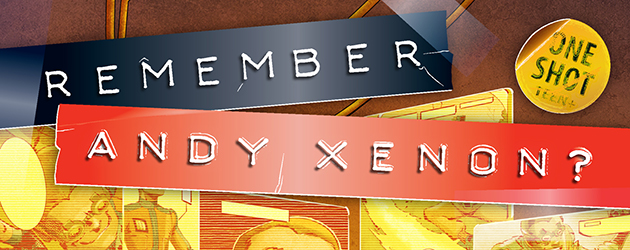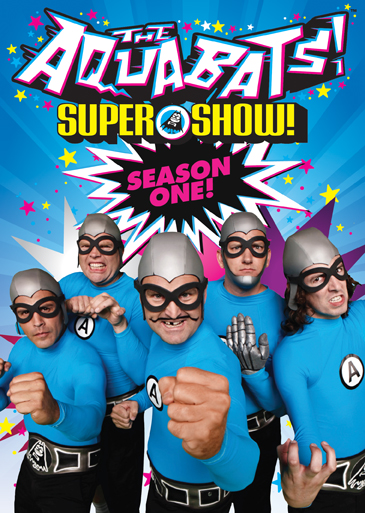What does it take to be a hero? Do the traits we generally associate with the virtuous side of masked vigilantism really paint the whole picture? How much does age play a part in that psychosocial soup that compels would-be adventurers to take the law into their own hands. In the case of child “adventurer” Andy Xenon, Creator Tom Pinchuk presents the notion that youthful exuberance can be its own motivation to launch oneself fully into the unknown.

As a rambunctious teen hero, Andy makes a name for himself and, for a time, holds the attention of the entire world. Unfortunately, for even the most resilient personalities, the cost of mainlining adrenaline is the eventual, oft spectacular crash. Some would self-destruct, others might be bested on the battlefield or hung low by unfortunate circumstance. For Andy Xenon, the fall proves rather unassuming, but offers pointed insight into the character.
Deftly complemented by impeccable art from Nikos Koutsis, Pinchuk’s deconstruction of the child hero trope is witty, inventive, and fun. It was a pleasure to be able to dig a bit deeper into this world with the help of the creator. Below, Tom and I discuss some of the process and experience that led him to create Andy and his universe. The exchange has been edited for brevity and clarity.
ComicAttack: Let’s start with a little bit of background information for our readers. Please introduce yourself and share some of your experience in comics and the entertainment industry as a whole.
Tom Pinchuk: I’m Tom Pinchuk, and I write for comics, TV, new media and everything in between. I’ve been calling myself a “man of duality” since my work ranges from blockbuster kid franchises like Ben 10 and Max Steel to edgy, mature readers material in Heavy Metal Magazine, among others. I’m hoping Remember Andy Xenon? will at last bridge that gap a little…!

CA: With the varied resume you have amassed, how do you differentiate, conceptually, between projects that are geared for print or the screen in your mind? Is it something that you tend to see well-defined at inception, or does the vehicle tend to evolve with the narrative?
TP: Any story is the sum of its parts – premise, characters, tone, theme, length. Change one during rewriting and the overall texture can shift a lot. The medium is one such part, for sure.
When the initial idea comes, I’m rarely conscious of which format it’d be best suited for, but there is a stage fairly early on where I’ll make that decision and shape the story accordingly. I really hate reading a comic where it’s obvious the writer just chucked a screenplay over a fence to the artist and said, “Go figure it out.” It’s crucial to understand the medium you’re working in and play to its strengths.
With Remember Andy Xenon?, there are more grown-up story concerns, of course – which I’ll get into in a minute – but it became clear it was best suited for comics for storytelling reasons early on. I really wanted to dig deep into Andy’s life, with layers of complexity that would’ve been overwhelming, coming at you 24-frames-per-second. So, rather than being something you watch for 22 minutes, then move on from to whatever’s next on TV, I wanted to craft an experience readers could sit with, sink into and find more layers of intrigue in with each re-read. If we’re not doing that, we’re simply not making the most of comics.
CA: We came into contact through your promotion of Remember Andy Xenon? and the Zoop crowdfunding platform. What inspired this book and why a one-shot versus a limited series?
TP: I had an original TV series in development at Cartoon Network which became a casualty of the Warner Brothers merger. After that, a moment of soul searching is unavoidable, really. I reflected on what got me into all this stuff in the first place, what stories had inspired me, and realized many were actually one-shots, or close to. The Death of Captain Marvel. Whatever Happened to the Man of Tomorrow? My favorite issues of Astro City were the one-offs. They have this poetic focus.
Instead of counting chickens before they’re hatched – which is what planning multiple seasons of a TV show during development at a network can feel like – I just wanted to get back to basics and make one story work. Protracting it over multiple parts felt like it’d only dilute our focus. Like the one-shots I mentioned, I wanted readers to feel like there were hundreds of issues behind Remember Andy Xenon? but they’re reading only the most important one. No homework needed beforehand. No holding back on the juicy stuff ‘til later, either. This is the one that distills our hero’s entire career to its most dramatic moment.
What made Andy’s specific story so compelling that you just had to share it?
TP: I was inspired by frustrated fans, actually!
I’d written on franchise reboots which had de-aged the heroes – making them kids again. They were great characters to work with, but not iconic to me the way I found they were to a generation of young adults. These fans had grown up with these heroes, becoming teenagers at the same time. As a result, they were vocal – often very vocal – about not liking reboots that made clear they’d “aged out” of the target audience.
Now, it makes every bit of sense to keep a kid hero show relatable to that target – kids. But still, I couldn’t help but sympathize. I remembered reboots aging me out of, say, Power Rangers or Ninja Turtles. It got me thinking… How would it feel for a kid hero to age out?
I just couldn’t shake the thought. It offered a poignant metaphor for growing up, life’s ups and downs, and more. I related a lot of my own experiences growing up to Andy’s predicament. It’s been awesome to find so many readers, from so many walks of life, have found it relatable, too.
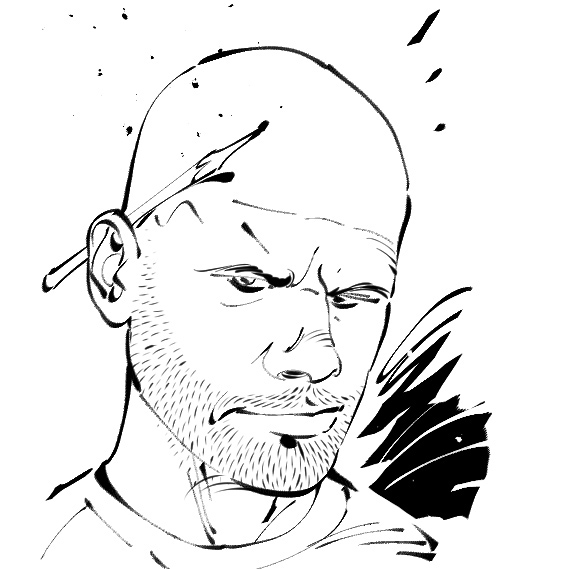
CA: How did Nikos Koutsis become involved in the project?
TP: Nikos and I have been collaborating for a couple years now. We had a limited series we were going to pitch around last year, but then the pandemic happened. All these editors we knew got laid off. Comics distribution in general was massively disrupted. It didn’t look like the right time for that series, but we still wanted to make something together and it made more sense to bring it straight to readers.
CA: How did the art style and design inform the narrative development?
TP: Nikos has such a dynamic range. I love how this lively cartoon energy is counterbalanced by realistic texture and detail at times. That tension fit perfectly for the back-and-forth of Andy’s recollections, contrasting these bright and sunny adolescent adventures with gray and dreary adulthood.
Were any of the visual aspects difficult to nail down, or were you both mostly on the same page?
The characters I’ve worked on belong to a newer generation of superheroes than ones introduced in the Golden Age or Silver Age. Instead of outfits inspired by circus strongmen, their style is more practical athletic wear. I told Nikos we needed tracksuits, jumpsuits and sneakers, not tights, capes and pirate boots, but the reason why wasn’t quite coming through. So, I sketched some character designs. Once he saw them, he understood what I was reaching for – then took them and made them all far better, too, of course.
CA: What was the most important thematic component that you wanted the art to convey and how was that achieved?
TP: The flashback panels needed to have a distinct look that was immediately discernible from the ones set in present day. Since we jump between eras so much, clarity was crucial. The look Nikos found with our colorist, Eva de la Cruz, was evocative of a Polaroid snapshot. The panel corners are rounded, colors are almost sun-washed, there’s a grainy texture. It all works to subtly suggest Andy’s flipping through a photo album as he reviews his life – which adds to the mood, I think, on top of keeping scene transitions crystal clear.
CA: In what ways does Andy’s story differ from your previous experience writing young heroes?
TP: Well, above all, he’s a twenty-something! Not a teen or tween. So, we get into more grown-up concerns – holding a job, dating, existential ennui and the like.
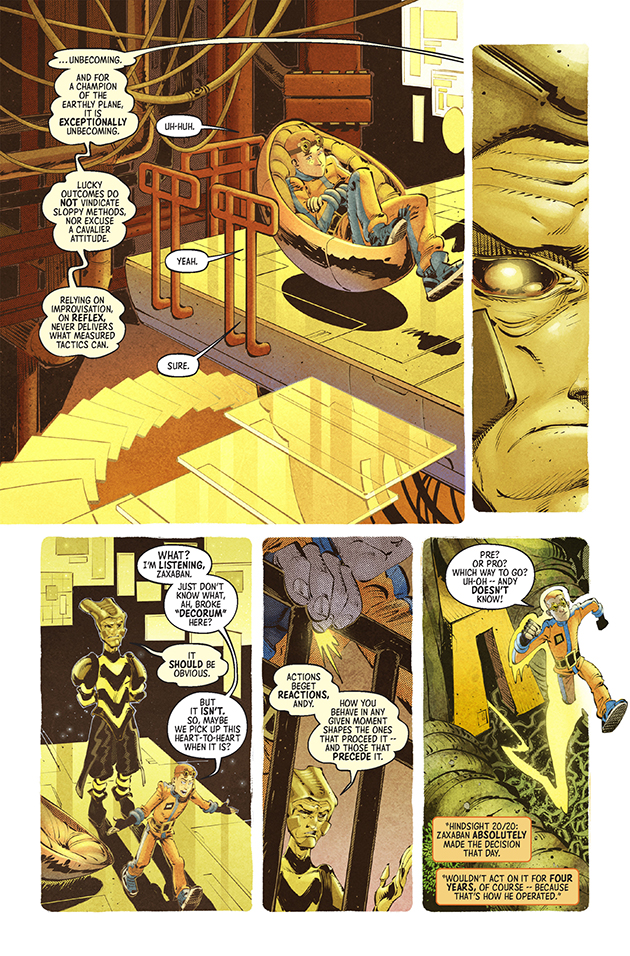
CA: Is it possible that working on those previous properties made Andy’s manifestation in your mind inevitable? Like maybe, based on the audience or format, there was a fair amount of depth and nuance left on the table that you just couldn’t ignore.
TP: Absolutely. It’s amusing to see fans’ video essays speculating that there are grown-up implications of a TV series’ premise which the writing staff somehow hasn’t considered. Kids shows are written by adults. Pretty much all questions get raised during writers room sessions, believe me. But most often, it just doesn’t fit to address them in the show.
A more innocuous example was on Ben 10, where the series bible spelled out that secret identities would simply be a non-issue. So, when Ben transforms into an alien, no bystanders find it unusual, and nobody ever recognizes him on the road. It’s a smart conceit, because it keeps the wish fulfillment uncomplicated, but it does leave a big question intentionally unanswered.
In Andy’s case, however, whether people recognize him, or if he wants to be recognized, is a huge concern! There are a lot of parallels to the identity crisis which older readers will grasp, but the classic “6-to-11-year-old demo” can’t relate to – and it’d be foolish to make a TV-Y7 cartoon episode expecting they could.
I’ve noticed every strain of adventure fiction has a “deconstruction” phase, too. Comics like Miracleman explore Shazam’s implications, for example. Anime like Madoka Magica finds mature angles on Sailor Moon. Phillip Jose Farmer’s “biographies” of Tarzan and Doc Savage make pulp heroes more realistic. Potentially being the first writer to give this hero generation’s archetypes such treatment was a creative challenge too exciting to resist.
CA: Speaking of depth and nuance, you’ve managed to develop a staggering microcosm in Andy’s universe. There’s a point where you change gears and, after a few pages, I realized how brilliant the shift was. It allowed you to infuse so much vital color and character into this world so efficiently. What prompted the change in narrative approach? With so much detail, you could have easily filled another 3 issues.
TP: I can spell out what this is more. We have a companion piece at the end of the book, “We Remember Andy Xenon” which is a magazine-style retrospective about Andy’s lost adventures. It has interviews with other adventurers who knew Andy, each with conflicting opinions of him and theories on what happened to him. Did he die? Retire? It’s written by a reporter who turns out to have a deeply personal reason for wanting to find out, too.
Now, I’m so glad you dug it! “Backmatter” is such a frumpy term, but a lot of comics I love have features like this. The “Under the Hood” biography excerpts in Watchmen and “New Traveler’s Almanac” in League of Extraordinary Gentlemen. The Wicked + the Divine has some super fun issues which are just interviews with the gods. Since an aim of the book was to make a kid hero feel more realistic, this felt like a fitting way to ground it even more.
The magazine format did let us pack in a lot more story, too – which was by design, for sure. We just took the term “one shot” to heart in every way and treated this like it was our only chance to play in this world. It’d be very easy to do more comics with the characters we’ve laid out, but if this is it, readers have a complete and satisfying story here, not an extended prologue.
What’s also cool is you can enjoy the feature comic just fine by itself, but reading the article will deepen your sense of what you just read. It adds context for some characters and even puts certain scenes in a new context. So, with each re-read, there’s more layers to find in the story.
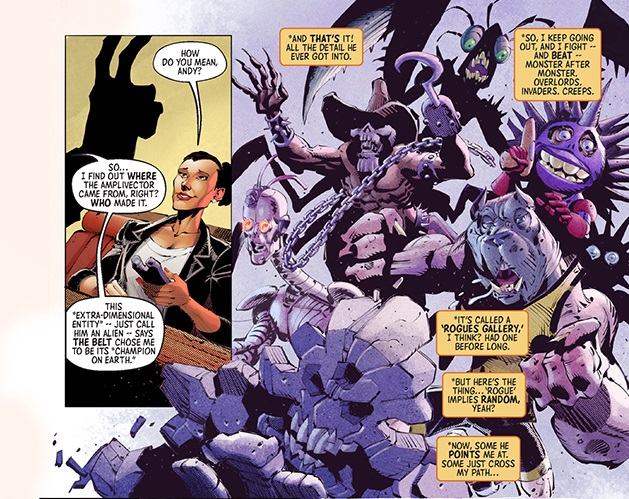
CA: Did you always plan on that change in perspective?
TP: Not from the beginning, but pretty early on. There was a wish list of guest artists I wanted to involve and I was figuring out how. Having them do spot illustrations directly connected to a narrative was far more interesting to me than just a series of pin-ups.
CA: Were you always confident the change would retain the immersive quality of your storytelling and keep the reader intrigued, or was it an experimental choice?
TP: Anything you make takes a risk, I think. Ha ha…
It didn’t feel so experimental to me because I could point to all the features I mentioned above which worked before. There was a stage where we considered making it shorter, but again… we’ve got one shot. If you’re going to do it, do it all the way. I did strive to make sure this was still an emotionally-engaging story in itself, not some dry “worldbuilding” appendix. So, each account of Andy’s adventures harps on the triumphs and tragedies he felt, and the interviews dig into the other adventurers’ own tragic backstories. I made sure readers got a big, rewarding payoff when they reached the end, too.
CA: Who was your favorite character to write and why?
TP: An obvious answer, maybe, but Andy. Again, I found a lot of easy analogies between his situation and experiences I’d had in my real life.
CA: How much did they change over the course of the narrative development?
TP: Without saying too much, at one point Andy meets an even younger kid hero and he turned to be more of a stitch to write than I expected. Maybe it was just refreshing to write a “teen troublemaker” who’s as foul-mouthed and nasty as 13-year-olds actually can be, as opposed to the Scholastic vision of misbehaving.
CA: Was there any character you didn’t like writing?
TP: Andy’s alien patron, Zaxaban, embodies all the qualities of bad teachers I’ve observed over my life, so writing him involved getting into an unpleasant mindset. But he was still easy to write. I may have regretted giving Andy’s alien enemies, the Urchin Agents, thick English accents at the start, because that required more research on slang later! Ha ha…
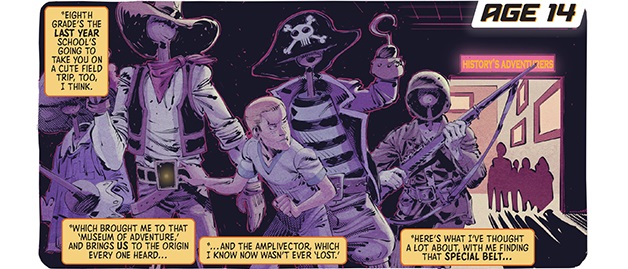
CA: Which character presented the most possibilities to expand on worldbuilding? You’ve created a very rich ecosystem that you obviously love to play in, so who is most likely to get you carried away, off-topic, and out in the boondocks exploring it?
TP: Andy’s would-be mentor, Basejump Baz, for sure. He’s represented most in the article, so I probably already got carried away with him. Ha ha… I like the dichotomy of this one-man G.I. JOE who’s a model of determination and totally on top of adventuring as a career but, in truth, is rather lonely when he goes home and the cameras are off.
CA: While Andy’s story seems quite singular and detached, Baz, Fran, and the Troubleshooters all have more fleshed-out support systems. Dysfunctional in some cases, certainly, but present at the very least. Do you think Andy envied them while he was part of that “community”? Do you think that is something that has changed for his character?
TP: Not when he was active, no. In the arrogance of youth, he wouldn’t see the value of support systems at all. He’d see the other adventurers as lame for relying on them, in fact. After he loses his powers, he certainly misses being part of the community, but still doesn’t know enough about their private lives to envy anything beyond them still being active and adventuring.
That’s at the start of the comic, though. Again, don’t want to reveal too much, but a lot of the story is about Andy meeting people who get him to appreciate things he took for granted before.
CA: What lies beyond the horizon for Andy Xenon? Are you looking forward to revisiting this particular rogues gallery with Andy, or maybe following another path?
TP: I’ve toyed with the notion of further one-shots centered on the other adventurers. There could be more to explore in Basejump Baz’s strained relationship with his siblings who’ve retired from adventuring. Following Fran Tastic in jail – or recently released from jail – would be interesting, too.
I find it impossible not to imagine follow-ups to whatever I’m writing, regardless of whether it fits or not. But again, going back to what I was saying earlier about counting chickens… I’d love to revisit the world, but if we don’t get a chance to, the book’s a complete statement on all the characters.

CA: How did you decide that Zoop was the right platform for this project? As a creator, why did you feel this crowdfunding model was more advantageous than Kickstarter or GoFundMe?
TP: I did a lot of research on crowdfunding and was repeatedly warned of the “hidden costs” of campaign management and fulfillment. Either you’re paying somebody to take care of all that, or you’re spending months printing mailing labels. So, what’s cool about Zoop is that they handle all that. They focus on what they’re good at – running a campaign, fulfilling orders – while I get more time to focus on what I’m hopefully good at, which is making the best comic I can. And that all benefits the readers at the end of the day.
Most importantly for me, Zoop has been very hands-on with the campaign, but they’ve let Nikos and I make the comic exactly how we wanted to make it. They understand the story and what we’re trying to do with it – which is a rarer quality in Hollywood than you’d think. Again, after doing my time in “Development Hell,” I can’t understate how refreshing it is to go straight to readers with an unfiltered vision. Zoop aren’t middlemen, they’re our support system.
CA: What other projects are you working out that you can share with us?
TP: I’m closing a deal with a publisher to do a set of one-shots. Depending on scheduling, Nikos may be drawing one of them. None of these are in Andy’s world, though, which is maybe an odd coincidence – or maybe a reaffirmation of how much I love the format. Ha ha… Some of my favorite comics were the Fifth Week Events the Big Two used to do all the time.
I’m well into scripting the limited series Nikos and I were working on last summer before the lockdown, as well. It’s a different genre – sword and sorcery – but if you like how we’ve handled Remember Andy Xenon?, you’ll very much like our approach. It’s a much bigger project, though, so it’s harder to say when it’ll be ready.
CA: Are you planning to focus on your own comics for now or are you dabbling in multiple prospects?
TP: I was just recently hired to write a couple animated TV bibles for a studio but, as it goes with development, I don’t know what will come of them. I hand the documents in and move on. I’m still doing that sort of stuff, but this experience working on Andy Xenon has made comics a bigger priority for me. I’ve got characters I want to introduce to an audience, and sooner rather than later. As I touched on above, you’ll definitely be seeing something more from Nikos and I, one way or another.
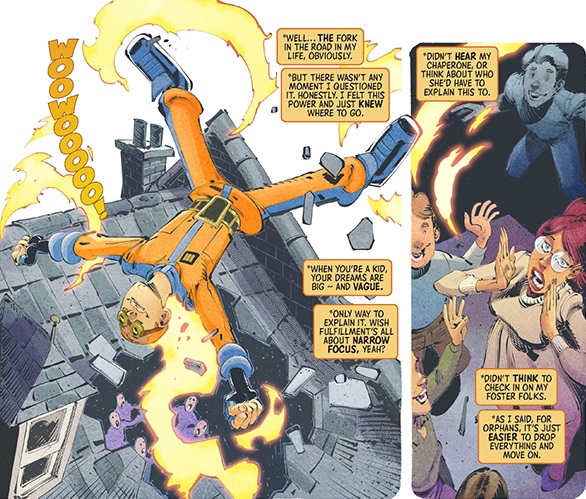
CA: Finally, as a personal touch for our readers:
What are you reading?
TP: Don Quixote. It’s research for another project. I didn’t really realize how Kick-Ass has the same basic premise, almost point by point, but maybe that shouldn’t actually be so surprising…!
What are you watching?
TP: Finally got around to marathoning Counterpart on Prime. It’s a brilliant transplanting of cold war spy intrigue into the “Earth 2” concept. And the gimmick of J.K. Simmons playing against himself works so well, you keep forgetting you aren’t actually watching two actors.
What are you listening to?
TP: Dug up Zach Hemsey’s The Way album again. He’s known more for his instrumental pieces being used in movie trailers all the time, but the album tracks like “Waiting Between Worlds” are a lot more compelling to me. They’re a very unique mix of spoken word, hip hop and orchestral.
As always, we at ComicAttack.net would like to thank Tom Pichuk for taking the time to share his thoughts and engage with our audience. Remember Andy Xenon? is available for pre-order on the Zoop crowdfunding platform now.
Christian Davenport
cable201@comicattack.net

